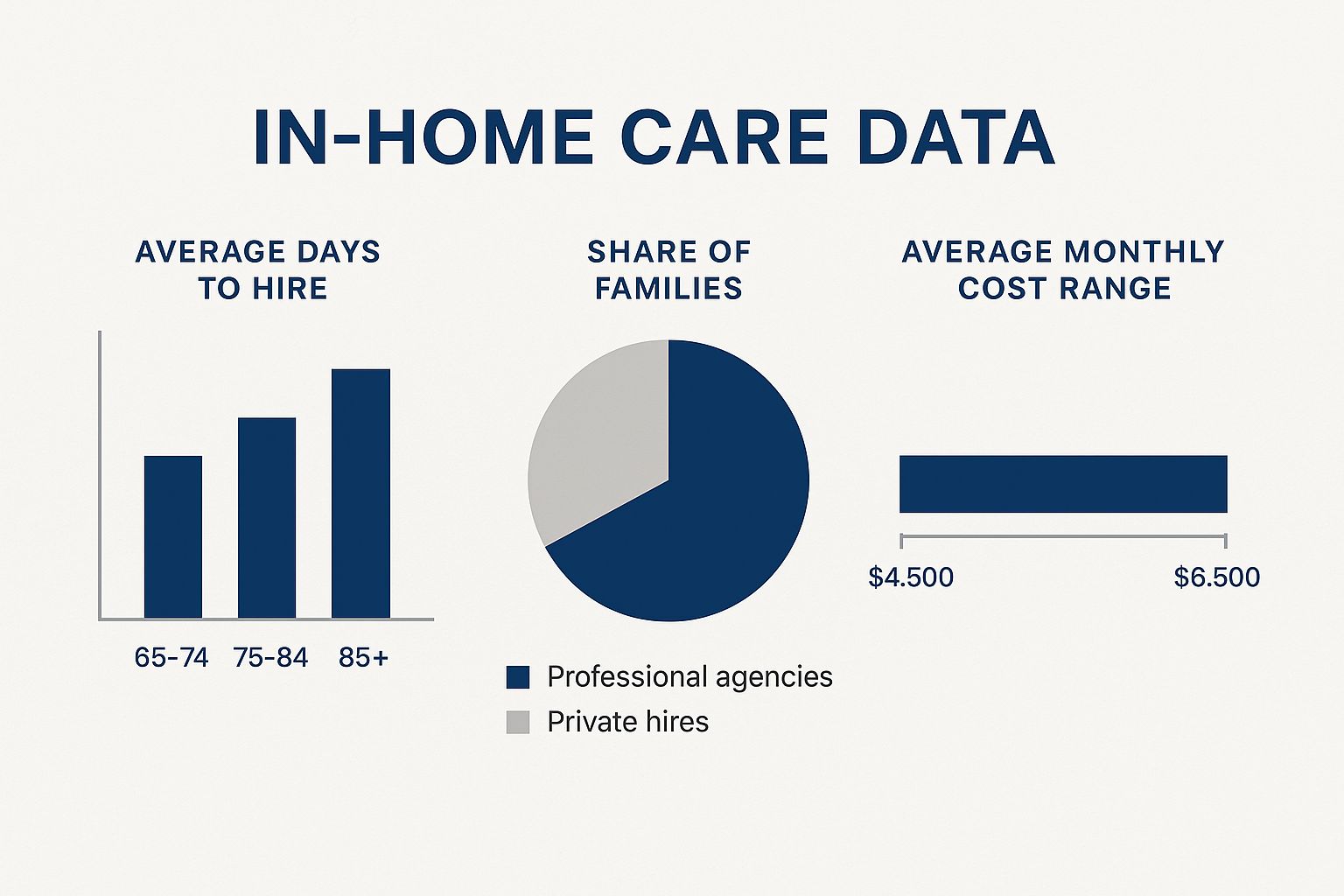The Real-World Landscape of In Home Senior Care

Today, in home senior care offers a broad range of services. These services address the diverse needs of aging individuals, going beyond basic daily assistance. The focus is on fostering a supportive atmosphere where seniors retain their independence and dignity. This can include anything from simple companionship to complex medical care.
Types of In Home Senior Care Services
Unlike the standardized setting of a facility, in home care provides a personalized approach. Care plans are customized to meet individual needs, addressing specific health issues, cognitive changes, and emotional well-being.
-
Companionship Care: This focuses on social interaction and emotional support, combating loneliness and isolation. Activities might include conversation, games, or outings.
-
Personal Care: This helps seniors with daily routines like bathing, dressing, and meal preparation. It allows them to maintain dignity and independence.
-
Skilled Nursing Care: Provided by registered nurses or licensed practical nurses, this addresses complex medical needs. These needs may include medication management, wound care, and other medical treatments.
The Growth of In Home Senior Care
The increasing need for personalized care fuels the growth of the in home senior care industry. The global elderly care market, including in-home options, has seen significant expansion. Reaching $1,782.6 billion by 2024, it is projected to reach $1,931.98 billion by 2025. This represents a compound annual growth rate (CAGR) of 8.4%. Factors contributing to this growth include the rise in age-related diseases, a growing aging population, and greater awareness of home care benefits. Learn more about this growing market in the Elderly Care Global Market Report. When building your care team, consider a Fractional Chief Operating Officer for flexible leadership.
Benefits of In Home Senior Care
Appropriate in-home support helps seniors maintain a sense of normalcy and control, often leading to better physical and emotional health. Remaining in familiar surroundings is particularly beneficial, especially for those with cognitive decline. This allows for continued social connections and participation in enjoyed activities. In home care strives to create a safe, comfortable, and supportive environment promoting overall well-being and quality of life. The following section will compare the benefits of home care with facility-based care to further demonstrate how in home care addresses the specific needs of aging individuals.
Home vs. Facility Care: What Research Actually Shows

The infographic above illustrates some interesting data surrounding in-home senior care. It shows the hiring timelines for caregivers across various age groups, how families find caregivers (agencies vs. private hires), and the average monthly costs. One key takeaway is the rising demand. Finding a qualified caregiver, especially for those 85 and older, takes time.
This emphasizes the need to plan ahead. The infographic also provides a valuable cost comparison. While in-home care can be expensive, it often offers greater personalization and flexibility than facility-based care.
To help illustrate the key differences between in-home care and facility-based care for seniors, we've created a comparison table:
Comparing In Home Senior Care vs. Facility-Based Care
A comprehensive comparison of key factors to consider when choosing between in-home care and facility-based options for seniors
| Factor | In Home Senior Care | Nursing Home Care | Assisted Living Facility |
|---|---|---|---|
| Cost | Variable, often less expensive than nursing homes but can be comparable to assisted living depending on care needs | Typically the most expensive option | Moderate to high cost, generally less than nursing homes |
| Personalization | Highly personalized care tailored to individual needs and preferences | Standardized care based on medical needs | Moderately personalized care with some flexibility in services |
| Independence | Promotes maximum independence and allows seniors to remain in their familiar environment | Less independence due to structured routines and medical oversight | Balance of independence and support services |
| Social Interaction | Can be more isolating depending on family and community involvement; caregivers can facilitate social activities | Opportunities for social interaction with other residents but can sometimes feel institutional | Varied social activities and opportunities for community engagement |
| Medical Care | Limited medical care; focus is on non-medical assistance | 24/7 skilled nursing care and medical supervision | Basic medical assistance and medication management; access to additional care if needed |
| Environment | Familiar and comfortable home setting | Clinical setting with shared rooms or private rooms | Apartment-style living with shared common areas |
The table highlights the differences in cost, personalization, independence, social interaction, medical care, and environment. In-home care excels in personalization and independence, while nursing homes provide comprehensive medical care. Assisted living offers a middle ground.
The Psychological Benefits of Aging in Place
Many studies demonstrate the psychological benefits of aging in place. Familiar surroundings provide comfort and security, positively impacting cognitive function and reducing depression and anxiety. Staying in a familiar environment can significantly enhance a senior's mental well-being.
Maintaining existing routines and social connections is also crucial for emotional health. This allows seniors to continue engaging in activities they enjoy and stay connected with loved ones, contributing to overall happiness and well-being.
Preserving Independence and Autonomy
In-home senior care focuses on preserving a senior's independence and autonomy. Unlike facilities with strict schedules, in-home care adapts to individual needs. Meal times, activities, and personal care routines can be adjusted to fit the senior's preferences.
This personalized approach fosters a sense of control and dignity, allowing seniors to maintain their individuality and make choices about their daily lives. It empowers them to continue living life on their own terms.
Addressing Safety Concerns With In Home Senior Care
While safety is a concern for families considering in-home care, solutions exist to mitigate risks. Simple home modifications like installing grab bars or improving lighting can greatly reduce fall risks. Personal emergency response systems (PERS) provide immediate help in emergencies.
This allows seniors to live independently while ensuring their safety. Regular check-ins by family or professional caregivers provide additional support and security. In-home senior care offers a balance of independence and needed support, ultimately improving quality of life for many seniors.
Finding Your Perfect Match: In Home Care Service Types

Not all in-home senior care is created equal. Finding the right type of care is essential for meeting individual needs and preferences. This section explains the various types of in-home care services available and helps you navigate the decision-making process. Understanding these distinctions empowers you to make the best choice for your loved one.
Companion Care: Combating Loneliness and Isolation
Companion care focuses on social interaction and emotional well-being. It's ideal for seniors who live alone and might be experiencing loneliness or isolation. Companion caregivers engage seniors in conversations, games, and other activities. They can also accompany seniors on outings and help them pursue hobbies.
For instance, a companion caregiver might join a senior for a community event, assist them with writing letters, or simply share stories and reminisce. This focus on emotional well-being can significantly impact a senior's overall health and happiness. Companion care enhances quality of life by providing meaningful connection and reducing social isolation.
Personal Care: Assistance with Daily Routines
Personal care provides assistance with Activities of Daily Living (ADLs). These essential activities include bathing, dressing, grooming, toileting, and meal preparation. Personal care helps seniors maintain their dignity and independence while receiving support with tasks they may find difficult.
Personal care services can also include medication reminders, light housekeeping, and transportation to appointments. This support allows seniors to remain comfortable and safe in their homes. The level of care can range from a few hours a week to 24/7, depending on individual needs.
Skilled Nursing Care: Managing Complex Medical Needs
Skilled nursing care is delivered by Registered Nurses (RNs) or Licensed Practical Nurses (LPNs). This specialized care addresses complex medical needs requiring professional expertise. Services can include medication management, wound care, injections, monitoring vital signs, and other medical treatments.
Skilled nursing care is often necessary for seniors recovering from surgery or illness, or those managing chronic conditions. This type of care is critical in allowing seniors to age in place safely and comfortably. The home care service market is constantly evolving. By 2025, the global market is expected to be valued at approximately $595.10 billion, reaching a projected $1,193.11 billion by 2032. Find more detailed statistics here. Learn more about our services in our article about our service categories.
Making In Home Senior Care Financially Feasible
Planning for in-home senior care can often feel overwhelming, especially when considering the financial aspects. However, there are several strategies and resources available to make quality care more affordable. Understanding the costs involved and exploring different payment options can empower families to make informed decisions. This section will guide you through the financial landscape of in-home senior care, offering practical advice for managing expenses.
Understanding the Factors Influencing In Home Senior Care Costs
Several key factors influence the cost of in-home senior care. One of the most significant is the level of care required. Skilled nursing care provided by a Registered Nurse, for instance, typically costs more than companion care. Geographic location also plays a significant role, as care costs can vary considerably between different areas.
Scheduling flexibility also affects pricing. Around-the-clock live-in care is understandably more expensive than a few hours of weekly assistance. Recognizing these factors helps families anticipate and prepare for expenses. When considering your options, it's helpful to understand the broader context of long-term care costs. For further information, you can review this helpful resource: Long Term Care Insurance Cost.
Exploring Funding Options for In Home Senior Care
Fortunately, various funding options can help offset the costs of in-home senior care. Medicare may cover some skilled nursing care or therapy services under specific circumstances. Medicaid offers more comprehensive coverage for those who qualify, although eligibility requirements differ by state. It's essential to note that neither Medicare nor Medicaid typically covers long-term non-medical care.
Private insurance policies might cover some in-home care services, but reviewing the details of your specific policy is crucial. In addition to traditional insurance, families should explore Veterans’ benefits, which may offer financial assistance to eligible veterans. For more resources and helpful information, you might be interested in: Our other articles.
Long-Term Care Insurance and Other Financial Strategies
Long-Term Care insurance (LTCI) can be a valuable resource, although it requires advance planning. These policies specifically cover the costs of long-term care, including in-home care. Investigating tax advantages, such as deductions for medical expenses, can provide additional financial relief.
Combining family involvement with professional care can also create a more sustainable and affordable plan. For example, family members can provide companionship and help with meal preparation, while professional caregivers assist with personal care or medication management. This collaborative approach can effectively reduce overall costs while ensuring the senior receives the necessary support.
To help illustrate the various costs and payment methods, the following table provides a detailed overview:
In Home Senior Care Costs and Payment Options
| Service Type | Average Hourly Cost | Average Monthly Cost | Typical Insurance Coverage | Alternative Funding Options |
|---|---|---|---|---|
| Companion Care | $25 – $40 | $1,500 – $2,400 | Limited Private Insurance, some LTCI | Private Pay, Veterans Benefits |
| Personal Care | $30 – $50 | $1,800 – $3,000 | Limited Private Insurance, some LTCI | Private Pay, Veterans Benefits |
| Skilled Nursing | $40 – $70 | $2,400 – $4,200 | Medicare (limited), Medicaid (for qualifying individuals), some LTCI | Private Pay, Veterans Benefits |
This table provides a general overview, and actual costs can vary depending on location and individual needs. It's crucial to research local providers and insurance policies for precise cost information.
Creating a Sustainable Financial Plan
Developing a sustainable financial plan for in-home senior care requires careful consideration of available resources and anticipated expenses. This includes obtaining transparent cost breakdowns from providers, exploring diverse funding avenues, and creatively combining various resources.
By proactively addressing the financial aspects of in-home senior care, families can create a plan that balances providing quality care with maintaining financial responsibility. This proactive approach allows families to ensure the best possible care for their loved ones while safeguarding their own financial well-being.
Technology That Transforms In Home Senior Care

Technology is changing the face of in-home senior care, offering solutions that promote safety, independence, and well-being. These aren't just fancy gadgets; they're practical tools addressing real-life challenges. Let's explore how technology enhances the lives of seniors aging at home.
Enhancing Safety and Independence
Adaptive equipment is key to a safer home. Items like grab bars, shower chairs, and raised toilet seats help prevent falls, a major concern for seniors. This allows them to maintain independence while reducing injury risk.
Medical alert systems offer an added layer of security. These devices let seniors quickly call for help in emergencies, providing peace of mind for both seniors and families. This is especially helpful for those living alone.
Medication management systems ensure seniors take medications correctly and on time. These range from simple pill organizers to electronic dispensers with alerts and adherence tracking. This technology helps prevent medication errors and promotes better health.
Monitoring and Communication Tools
Remote monitoring systems let families and caregivers check on seniors' well-being. Sensors detect changes in activity or environmental conditions. A sensor could detect a fall or a sudden temperature change, for example.
Video conferencing and other communication tools help seniors connect with loved ones. These tools facilitate social interaction, combat loneliness, and improve emotional well-being. They also reduce feelings of isolation. Senior care products are increasingly designed with this in mind.
In 2025, the market for these products is expected to reach $312.4 billion. It's projected to grow at a CAGR of 8.1% between 2025 and 2035, thanks to the growing senior population and advancements in geriatric care. Learn more here.
Smart Home Technology For Seniors
Smart home technology offers many benefits for seniors aging in place. Voice-activated assistants like Alexa control lights, appliances, and thermostats, simplifying daily tasks. Smart lighting systems automatically adjust light levels, improving visibility and reducing fall risks.
Smart locks and security systems enhance safety and provide peace of mind. These can be controlled remotely, allowing family to monitor and manage home access.
The Role of Technology in Complementing Human Care
While technology provides valuable support, it complements, not replaces, human interaction. The human element is crucial for emotional support, companionship, and personalized care. Technology enhances these efforts, not replaces them.
By integrating technology into in-home senior care, we create a safer, more comfortable, and engaging environment for seniors aging in place. These tools empower seniors to live more independently while staying connected with their families and communities. They also provide caregivers with valuable resources to improve the quality of care they provide.
Building Your Dream Team: Selecting Care Providers
The heart of successful in-home senior care lies in the relationship between the caregiver and your loved one. Finding the right fit can be challenging. This section offers practical guidance for identifying exceptional care providers who truly align with your family's needs and values. Building this "dream team" requires careful evaluation, open communication, and a focus on compatibility.
Evaluating In-Home Senior Care Agencies and Providers
Don't rely solely on marketing brochures. Investigate potential care providers thoroughly to assess their true quality. When evaluating agencies, ask specific questions about their caregiver screening process. What types of background checks do they conduct? How do they evaluate a caregiver's experience and qualifications?
Ask about their training programs. What specific skills do they teach their caregivers? How do they handle specialized care needs, like dementia care or medication management? Ongoing training demonstrates a commitment to quality care.
Finally, understand their supervision practices. How do they monitor caregiver performance? Do they conduct regular check-ins and offer ongoing support? Thorough supervision ensures consistent care that adapts to your loved one's changing needs.
Interviewing Potential Caregivers: Key Questions and Red Flags
The interview is crucial for determining compatibility. Prepare questions that delve deeper than basic qualifications. Explore a potential caregiver's personality, values, and caregiving philosophy.
- How do they handle difficult situations?
- How do they communicate?
- What are their personal interests?
Look for genuine compassion and a dedication to providing respectful, individualized care.
Be mindful of red flags such as evasive answers, disinterest in your loved one's specific needs, or reluctance to discuss experience. Trust your instincts. If something feels wrong, it probably is. You might be interested in: Our job listings.
Protecting Your Interests: Contracts and Agreements
Before finalizing arrangements, review the contract thoroughly. Ensure it clearly outlines services, schedules, costs, and cancellation terms.
Pay attention to clauses regarding liability, insurance, and backup care. A well-defined contract protects both your family and the caregiver, promoting clarity and preventing misunderstandings.
Fostering Successful Care Partnerships: Communication and Transition
A smooth transition is essential. Introduce the caregiver to your loved one gradually, allowing time to connect and build rapport.
Establish clear communication channels. How will you receive updates? How will concerns be addressed? Regular communication builds trust and keeps everyone informed.
Creating a Supportive Environment for Caregivers
Caregivers are valuable team members. Create a respectful and supportive environment where they feel appreciated. This includes clear instructions, open communication, and regular feedback.
When caregivers feel valued, they're more likely to provide compassionate, dedicated care, contributing significantly to your loved one's well-being. By following these steps, you can build a dream team of care providers who become trusted partners in your loved one's aging journey. Learn more at Caring Hands Senior Services.



